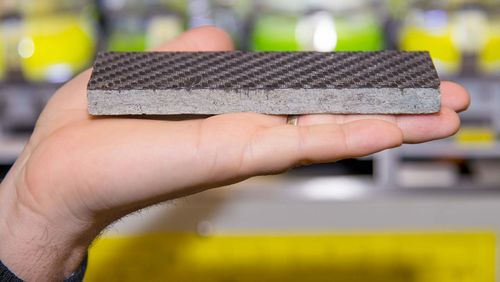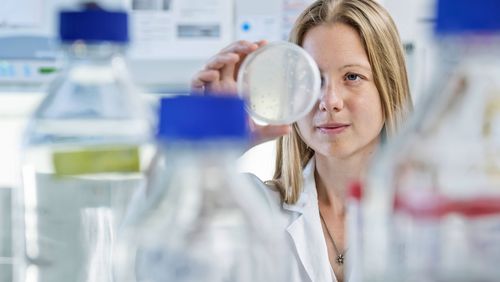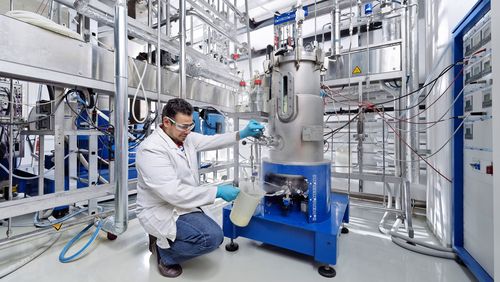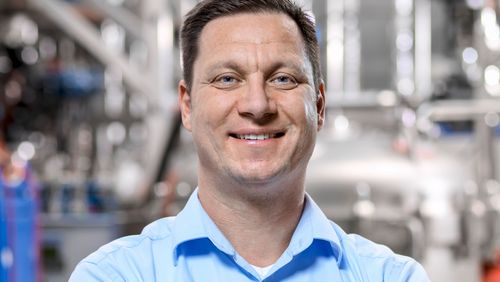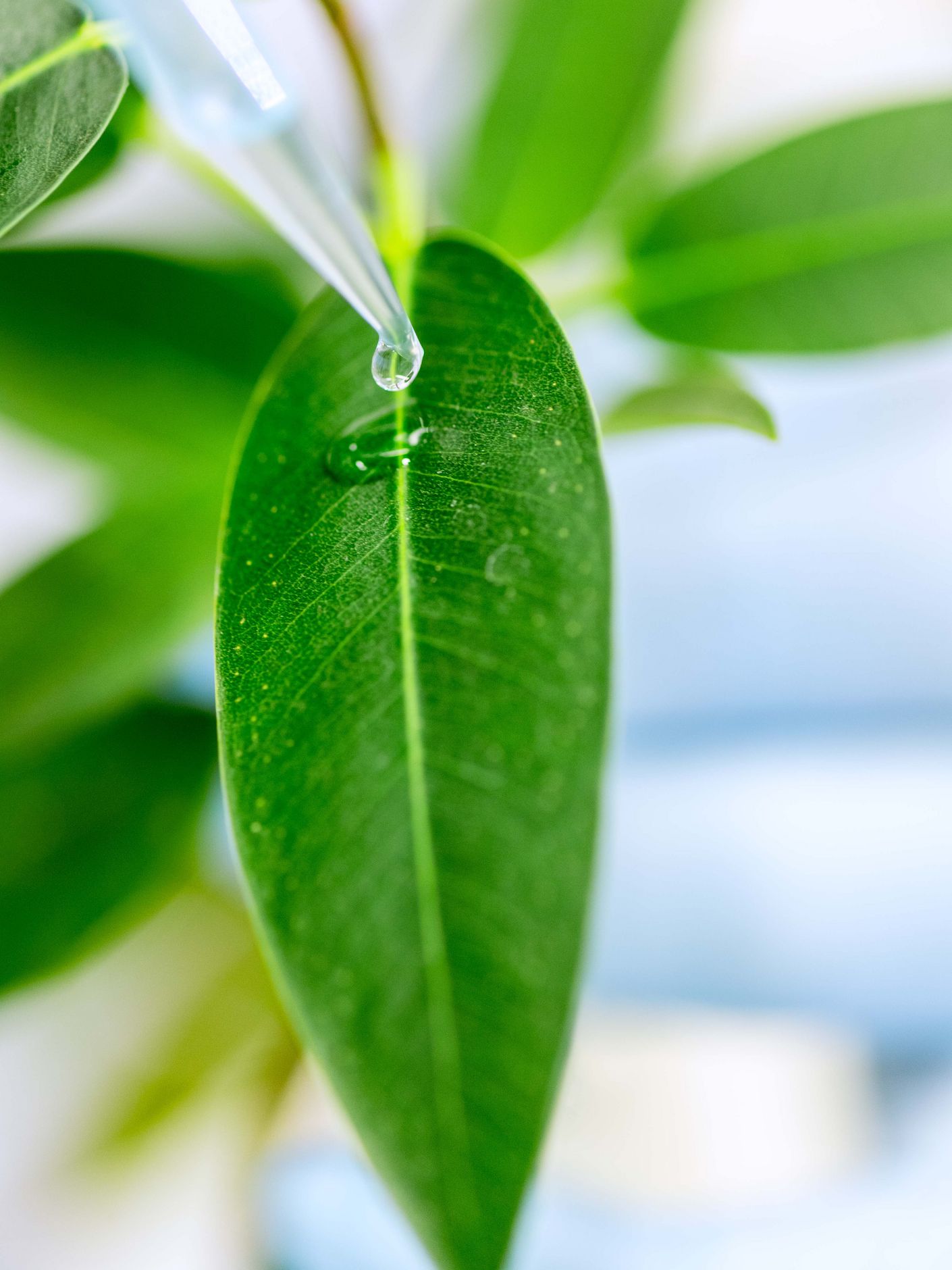
Be gone, pest!
2018 brought good fortune to bees—and to the team at Synthetic Biotechnology. In February 2018, the EU issued a ban on conventional pesticides from the neonicotinoid group, which are known to harm pollinators such as bees. As chance would have it, Professor Thomas Brück and his team at Synthetic Biotechnology presented a biologically degradable pest deterrent soon after the ban was issued. The innovative substance does not poison insects but simply repels them, much like a mosquito spray. “The echo generated by our discovery was unbelievable,” says Brück, who holds the Werner Siemens Foundation Endowed Chair at the Technical University of Munich.
The EU ban on seven internationally approved, highly effective pesticides from the neonicotinoid group caused an uproar in the agricultural sector. Farmers’ associations immediately began demanding a replacement, and they want it fast. Growers of sugar beets and wheat—two major crops in Germany—are in particularly dire need of a new pest-control product. To be sure, scientists have long provided evidence that neonicotinoids kill not only sucking and chewing pests such as aphids or whiteflies but also bees, bumblebees, butterflies, beetles, grasshoppers and other beneficial insects. The contact and systemic poisons in pesticides attack the insects’ nervous systems, leading first to cramps, then death. Nevertheless, neonicotinoids continued to be used widely in farming. Until, that is, the publication of a 2017 study by Wood and Goulson demonstrating the adverse effects the substance has on the ecosystem of the most important pollinators. The EU has also recognised that the decimation of bees and other pollinators is “collateral damage” from the use of neonicotinoids—and that we simply cannot afford to lose more bees, especially in light of the bee colony collapse disorder observed in a variety of regions. After all, without pollinators, the world’s food supply is seriously at risk. As a consequence, the EU issued a ban on neonicotinoids in February of 2018. And ever since, Thomas Brück has been inundated with requests for the innovative pest-control substance developed by his team at Synthetic Biotechnology, at the Technical University of Munich (TUM).
Repel, not poison
Rather than functioning like a conventional pesticide, the innovative technology works more like a mosquito spray. “Our organic pest spray doesn’t kill insects. Instead, it repels them for a certain period of time,” says Brück. The innovative spray consists mainly of the molecule cembratrienol—a natural pest repellent—and is biologically degradable. True to their general approach, the researchers at Synthetic Biotechnology took inspiration from nature and naturally arising organisms when developing the active agent for the spray. This time, the model was the tobacco plant, which produces cembratrienol in its leaves. To date, the efficacy of the product has been tested only on aphids—because “they can’t run away, meaning we can keep count of them”, explains Professor Thomas Brück. The initial results were very promising.
A resounding echo
On 6 June 2018, TUM issued a news release about the tests, triggering a barrage of requests for the technology. The Landwirtschaftsministerium (Ministry of Agriculture) in Bavaria and even the German Federal Ministry of Food and Agriculture have contacted Brück and his team. As have big names in the agricultural sector, including German food company Südzucker—Europe’s largest sugar producer—as well as agricultural chemical companies from the Netherlands, Austria and Switzerland.
A threat to sugar
Because sugar in Germany, the UK and the Benelux countries is produced mainly from sugar beets, the production of sugar in northern Europe is particularly affected by the ban on nicotinoids. Brück says, “Sugar beets are vulnerable to a virus carried by aphids, so it’s natural that sugar beet growers want to work with us to address the issue of pest control quickly.” In an initial step, the team at Synthetic Biotechnology is working with the Institute of Sugar Beet Research at the University of Göttingen—the key research facility for the development of sustainable sugar beet production in Germany. TUM and the Institute of Sugar Beet Research are also collaborating with the Bavarian Ministry of Agriculture and the
German Federal Ministry of Food and Agriculture to test the pest-control spray and evaluate its effect on sugar beet aphids.
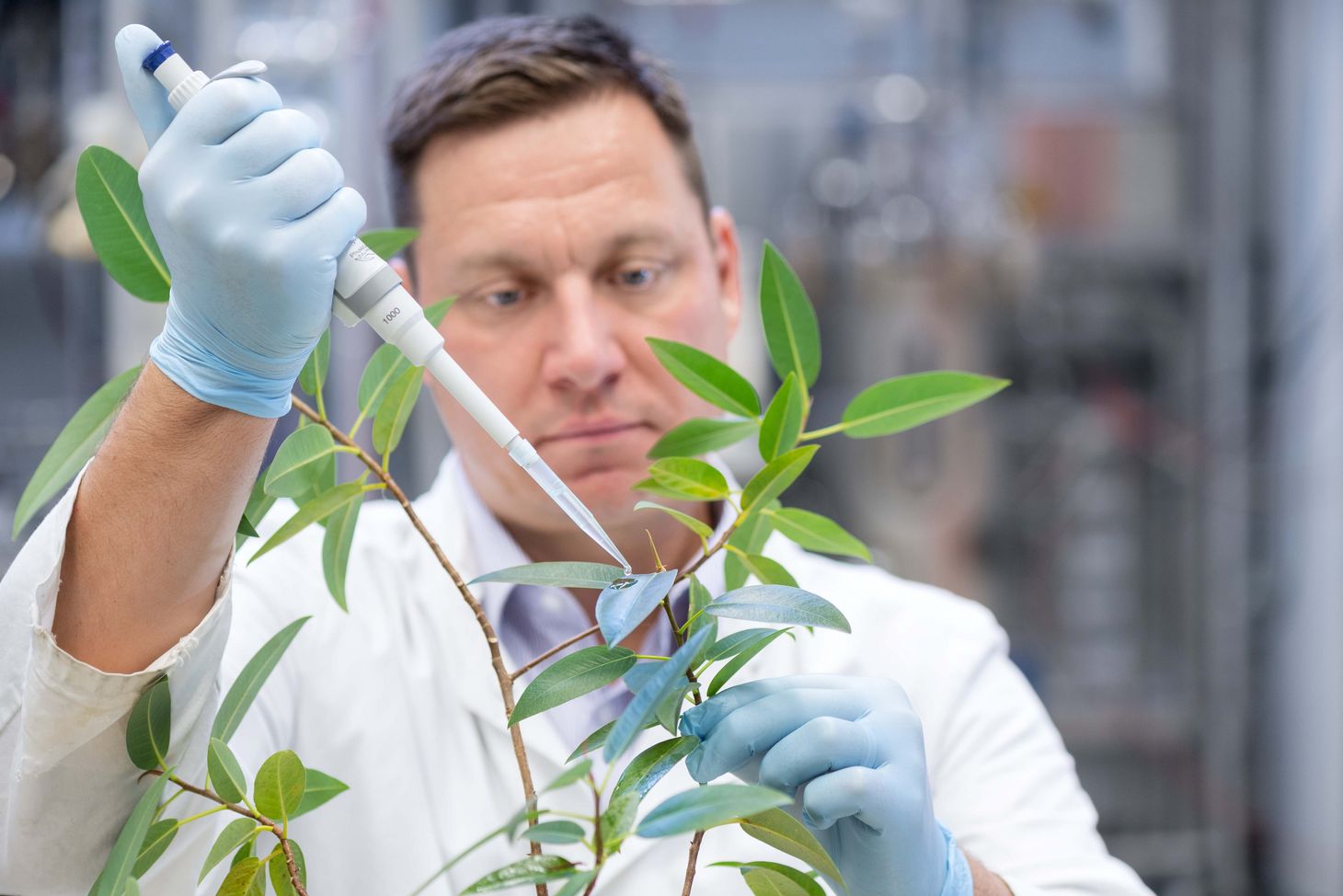
Even greater success
“We have to devise a special formula for the cembratrienol,” Brück says. “Formulating the agent as an oily substance would lengthen its retention time and thus significantly improve the protection it offers.” When Thomas Brück mentions an oily substance, he naturally thinks of “his” oil-producing yeasts, which he would like to use to improve the active agent in the pest-control spray. “We’ve begun producing oils with the repellent odour in genetically optimised yeasts,” he explains. “This allows us to spray our formulation for the agent directly on the sugar beets, wheat and other plants.” The active agent should also repel whiteflies and fruit flies (which damage fruit crops) and, as such, “could even protect the aromatic apricots grown in Valais”, Brück says with a nod and a wink towards Switzerland.
From spin-off to EU approval
The various agricultural chemical companies that have contacted Thomas Brück plan to add the innovative pest-control substance to their own products in order to achieve the best-possible protection. Now, the TUM professor and Werner Siemens Foundation Endowed Chair is entertaining the idea of a spin-off company that would produce the substanceand sell it to the agricultural chemical industry. Ideally, Brück sees a broad range of uses for the substance—from industrial-scale farms to private gardens. But the goal will be difficult to achieve. The largest obstacle is posed by the EU regulators responsible for approving new agricultural chemicals. “It takes between three and five years for a new agent to be approved,” Brück explains. During the waiting period, Synthetic Biotechnology will have to invest its own funds to guarantee that the team can maintain their innovative momentum and transform the initial product into a market success.
Oil and folic acid from algae
The pest repellent was not the only progress made by the team at Synthetic Biotechnology in 2018: Microchloropsis sp., an oil-producing microalga, proved itself to be a major production organism: it grows faster and binds more oil than other kinds of algae. Dunaliella sp., by contrast, is better suited to producing folic acid. It generates extremely high folate values, 10 times higher than in folic-acid-rich vegetables (such as white beans) or fruit (for instance honey melons). Over the course of the next two years, Brück expects that the procedures to produce folic acid can be marketed as patent licences.
Cancer drug Taxol
Another highlight in 2018 at Synthetic Biotechnology was the successful conclusion of the project to sustainably produce the cancer drug Taxol. The team found a new way of producing the Taxol precursor that pharmaceutical companies can use to produce the sought-after cancer drug. Although the pharma industry has signalled its interest, the approval procedures for new pharmaceutics are both very complicated and very expensive. “It’s a tightrope act,” says Brück, “and only large pharmaceutical companies can afford to be contenders. Funds in the amount of 100 million euros are easily used up before a process is certified.” It is not yet clear which company is willing to step in. Despite the open questions, work on further expanding and diversifying the technology platform for producing Taxol is underway: a proposal with partners from France, Israel, Italy, Australia, Austria and Germany has been submitted to the EU. In this case, the goal is to translate the gains made at Synthetic Biotechnology into the production of new cancer therapies, antibiotics and anti-inflammatory agents for the pharmaceutical sector.
A bioreactor from a 3D printer
Last but not least, Thomas Brück has come closer to realising his dream of the perfect bioreactor—a device in which yeasts and algae go in at the top and come out at the bottom as the targeted products—for instance oils or Taxol. At the start of 2019, an important step will be taken: the team can take up quarters in a new space furnished with state-of-the-art equipment. Then it is full steam ahead with the 3D printing of the bioreactor. For this project, the team at Synthetic Biotechnology is basing its methodology on the food industry rather than taking inspiration from nature. Already today, food companies like Nestlé or Danone use 3D printers to tweak the consistency of foods such as yoghurt and pudding, and the team at Synthetic Biotechnology is modifying these processes for its purposes. There is a futuristic element to the entire endeavour—and, indeed, it will most likely be another 10 years before 3D printers are ready to produce just about anything, including new foodstuffs—and entire bioreactors.
Text: Brigitt Blöchlinger
Photos: Andreas Heddergott

